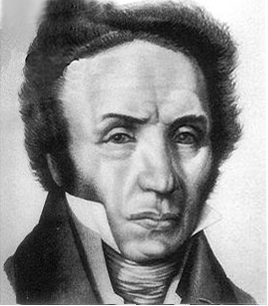
André Michaux, also styled Andrew Michaud, was a French botanist and explorer. He is most noted for his study of North American flora. In addition Michaux collected specimens in England, Spain, France, and even Persia. His work was part of a larger European effort to gather knowledge about the natural world. Michaux's contributions include Histoire des chênes de l'Amérique and Flora Boreali-Americana which continued to be botanical references well into the 19th century. His son, François André Michaux, also became an authoritative botanist.

Guillaume-Antoine Olivier was a French entomologist and naturalist.

The sculptured Dendera zodiac is a widely known Egyptian bas-relief from the ceiling of the pronaos of a chapel dedicated to Osiris in the Hathor temple at Dendera, containing images of Taurus and Libra. This chapel was begun in the late Ptolemaic period; its pronaos was added by the emperor Tiberius. This led Jean-François Champollion to date the relief to the Greco-Roman period, but most of his contemporaries believed it to be of the New Kingdom. The relief, which John H. Rogers characterised as "the only complete map that we have of an ancient sky", has been conjectured to represent the basis on which later astronomy systems were based. It is now on display at the Musée du Louvre, Paris.
Alire Raffeneau Delile was a French botanist.

Henry Laurens is a French historian and author of several histories and studies about the Arab-Muslim world. He is Professor and Chair of History of the Contemporary Arab World at the Collège de France, Paris.
The Commission des Sciences et des Arts was a French scientific and artistic institute. Established on 16 March 1798, it consisted of 167 members, of which all but 16 joined Napoleon Bonaparte's conquest of Egypt and produced the Description de l'Égypte. More than half were engineers and technicians, including 21 mathematicians, 3 astronomers, 17 civil engineers, 13 naturalists and mining engineers, geographers, 3 gunpowder engineers, 4 architects, 8 artists, 10 mechanical artists, 1 sculptor, 15 interpreters, 10 men of letters, 22 printers in Latin, Greek and Arabic characters. Bonaparte organised his scientific 'corps' like an army, dividing its members into 5 categories and assigning to each member a military rank and a defined military role beyond his scientific function.
François Michel de Rozière was a French mining engineer and mineralogist.
Jean-Jacques Castex was a French sculptor.

Jean-Joseph Marcel was a French printer and engineer. He was also a savant who accompanied Napoleon's 1798 campaign in Egypt as a member of the Commission des Sciences et des Arts, a corps of 167 technical experts.

Jean Vercoutter was a French Egyptologist. One of the pioneers of archaeological research into Sudan from 1953, he was Director of the Institut Français d'Archéologie Orientale from 1977 to 1981.

André Dutertre was a French painter.

Jacques-Marie Le Père was a French civil engineer.

Gratien Le Père was a French civil engineer.
Mathurin François Boucher was a French naval engineer. He is notable for his adaptation of the technique of Ship camel to large 74-guns, and for designing the Surveillante class of 60-gun frigates.
Ernest Fouinet was a 19th-century French novelist and poet.
Gaston Wiet was a 20th-century French orientalist.
Jean-Michel de Venture de Paradis was an 18th-century French orientalist.

Guillaume André Villoteau was a French musicologist.
Jean-François Xavier Rousseau was a French diplomat and orientalist, nicknamed 'Rousseau of Persia'.
Jean-Baptiste Miroudot du Bourg was a French bishop.










